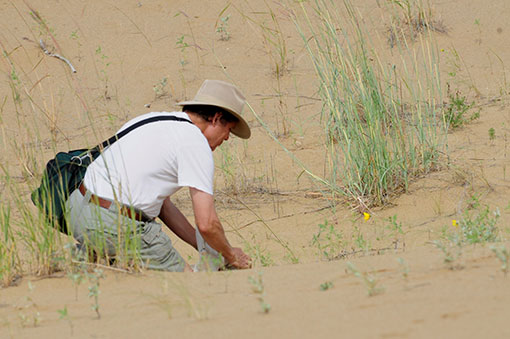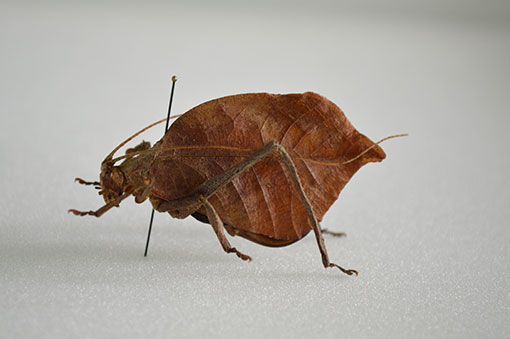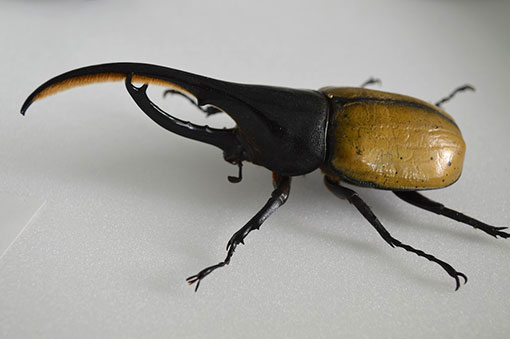
Bob Wrigley C'61 - Life Member, collecting insects in mixed-grass prairie near Brandon, Manitoba. (photo by Larry de March).
Items I particularly enjoy reading in the Alumni Connection deal with the careers and hobbies pursued by graduates of our high school. Sometimes these two activities are closely related, while others could not be more different; I have written about both types before in our newsletter (i.e., fossil hunting and woodcarving). Towards the end of my career, I discovered entomology -- the study of insects and their relatives. Oddly, I had never paid much attention to ‘bugs’ before, in spite of being an ecologist. I suspect that one becomes so specialized or focussed on one field that it is challenging to find the time for, or to embark upon, another unknown subject. Often it just takes a chance encounter with a subject or person to open up a whole new adventure.
Retirement means there should potentially be time to take up new or long-postponed activities. These can certainly add to our quality of life and help keep us young and active, both physically and mentally. As I think about it, being outdoors and enjoying Nature is something I and my friends were constantly exposed to growing up in St. Lambert, as we were surrounded by forests, fields, swamps, and our favourite play-ground -- the St. Lawrence River.
In my own case, my ‘moment of enlightenment’ came when I was near the end of my term as the Director of the Oak Hammock Marsh Interpretive Center, north of Winnipeg. A young man, Chris Pedersen, walked into my office one morning and enquired whether the Center would be interested in hosting a display of colourful butterflies, beetles and other tropical insects. I was pleased to support his idea, since interpretive centers and museums are always looking for ways of attracting, educating and entertaining the public and students. As we worked together to prepare what turned out to be a highly attractive and successful exhibit involving hundreds of his amazing specimens from around the world, I could not help but become enthralled over the wonderful colours, anatomy and adaptations of these insects. Chris invited me to his home to view the rest of his collection, laid out neatly in trays, and he demonstrated how to prepare specimens that he had caught or received dry-mounted in the mail. I tried my hand at preparing a few beetle specimens from Thailand -- something that came naturally to me, since I had prepared over a thousand small mammals and birds in my previous career as a museum curator at the Manitoba Museum. This tiny spark of interest burst forth into a flame of new passion for me, which since then has occupied much of my time and energy.
From April to October, I am often out in the field throughout southern Manitoba with my butterfly net, sweeping vegetation high and low, or with an aquatic net scooping the shallows of ponds and creeks, always hoping to find new species for my collection, and if I am really lucky, new species’ records for the province. I have been able to overcome a slight tinge of embarrassment at carrying a net, largely ignoring the weird or humorous glances from some people, and honks from passing cars. One highway-patrol officer, checking my presence on a railroad property in Nebraska, commented that he could determine from a distance that I was harmless because I was carrying a butterfly net.
I and usually a retired friend embark on one or two major expeditions annually to destinations in the United States and as far south as Costa Rica, to reach different habitats and access hosts of new insect species. Having collected in about 30 states and provinces, my favourites continue to be Florida and Arizona in June and July (yes, in the heat); the biodiversity of these areas in mid-summer is unbelievable. Some species may be captured during the day, but many others are nocturnal, and so we actively search for bugs under night-lights until mid-night or longer. These can be security lights from businesses, or my special mercury-vapour light, which often attracts insects by the thousands onto a white sheet. One never knows what interesting species will come flying in, and then we try to grab them before they fly off into the dark.
On a number of occasions, we have been approached at night by police officers, checking on what we are doing walking suspiciously behind banks, liquor stores and gas stations with flashlights and headlamps. Fortunately most of these encounters were friendly, and we felt safer knowing that the streets were being patrolled. One kindly Arkansas officer warned me that I was in a dangerous neighbourhood, and if I wanted a better place to collect bugs, I should go to the local penitentiary. He even drew me a map of how to get there, and mentioned that I would be on close-circuit TV the entire time I was walking under the bright lights of the perimeter fence. It was an interesting and successful night, well worth going to jail for.
This July, a friend and I travelled by car along the old Oregon Trail to Oregon and Washington, enjoying the wildlife and landscapes while hiking for hours in the sun and fresh mountain air. We also could not pass up visiting a number of national and state parks, fish hatcheries, natural-history museums, and wildlife-art galleries. On this and with past trips, we return home with thousands of specimens (preserved dry or in alcohol) representing hundreds of fascinating species, which we prepare, identify and label during the winter months. This specimen-preparation process is satisfying, working with our hands and using a stereoscope, books, journals and the internet to determine the names of species. It may take half-an-hour or more of careful detective work, but it feels so great to finally figure out the name of a bug (although I am not quite certain why this is so). Looking at a tray of expertly prepared and arranged insect specimens is perhaps something only an entomologist can fully appreciate. And it’s amazing how much Latin and Greek terminology I have picked up over the years.
Even when on vacation with my wife Arlene, I cannot resist searching the ground and gardens for insects. When we spent several weeks this June in Italy (where Arlene took a mosaics course in Ravenna) and Germany (visiting friends), I was able to collect several hundred specimens, all new to my collection. Strolling along historic streets, beetles still kept popping up in arts and crafts, and in shops selling chocolates. In the well-known chocolate shop, Niederegger in Lubeck, Germany, I discovered a surprising number of chocolates in the shapes of various common insects, such as lady beetles. A stag beetle motif commonly appeared on fronts of buildings and on coats-of-arms.
My personal collection has risen to over 10,000 species of beetles (likely over 30,000 specimens) from around the world, acquired through my collecting activities, exchanges, and purchases through the internet; yes, one can actually order packages of dead, dried insects from numerous private and commercial dealers. Some beetles are as large as my fist, while others are barely a millimetre in length. Some look like they have been dipped in gold or silver, while others are drab with camouflaging patterns. Certain ones can even change colour (through refraction of light) when orientated in different positions. In fact, many beetles are every bit as colourful as butterflies and coral-reef fishes. Once a doubtful visitor to my home sees my collection, they suddenly understand why I am so captivated by insects. I view them as little gems from exotic places around the globe -- jungles, deserts, mountains and savannas that l will never have the opportunity to visit in person. It is humbling to me that while insects evolved 400 million years ago, our own species is not even 200,000 years old. Insects are the most-diverse group of organisms on Earth and are the most-ecologically dominant animals on land, although our species makes every effort to be number one.
With beetles species numbering in the millions (with many yet unknown) and often occurring in great numbers of individuals, my collections would quickly overcome my cabinet capacity, so I donate about 1600 specimens annually to the Manitoba Museum and the Wallis-Roughley Museum of Entomology in Winnipeg, the Canadian National Collection of Insects in Ottawa, and the Montreal Insectarium. For these valuable donations, I receive tax receipts, which help cover next-year’s travel expenses. These specimens (with my name on the labels) will be available for study for many centuries to come, which I find satisfying. In fact, much of what is known about insects has been discovered by amateur naturalists, and sadly there are ever-fewer entomology courses at universities, and employment opportunities for professional entomologists.
Another off-shoot of my insect hobby is writing field notes and publishing the results of my observations. It is gratifying to see my efforts in print, and to occasionally hear from a professional entomologist that they appreciate my specimen donations and the articles. To my astonishment, the Entomological societies of Canada and Manitoba honoured me in 2009 with the Norman Criddle Award; “in recognition of outstanding work among amateur entomologists.” I have just now begun to write a book about my lifetime adventures while studying wildlife, and many of these short stories are about my pursuit of insects. An artist friend is preparing cartoons to illustrate some of the humorous accounts.
While I readily admit that beetle research and collecting seem a strange hobby or occupation to most people in North America, there is a long history of insect appreciation in other parts of the world. A number of well-known naturalists, such as Charles Darwin, Alfred Russel Wallace and Henry Walter Bates (all of ‘origin of species’ fame) began their career paths as youths collecting beetles. Beetle and butterfly collecting and research have been undertaken for three centuries by literally thousands of professionals and amateurs in Eurasia, and more recently in North America, South America and Australia, and there is now a vast literature on these subjects. Prize specimens of butterflies and beetles are purchased by connoisseurs for tens of thousands of dollars, and the dead-insect trade amounts to over a billion dollars annually, with significant numbers of specimens coming from sustainable-farming enterprises, and being harvested as a renewable resource in preserved natural habitats. However, there is a growing concern about commercial over-collecting, and certain countries have now banned exportation of insects and other wildlife for conservation reasons. However, habitat destruction from agriculture and development in our over-populated world are by far the most-critical factors in the current mass-extinction event, from which insects cannot escape.
Insects in the diet has not yet caught on in North America, but in many other countries, especially Southeast Asia, a variety of insects are considered a staple, or at least a delicacy, and are widely available in shops and restaurants. Ironically, we eat, through our lifetime, significant amounts of insect parts in our food (e.g., in grains, fruits and vegetables) without our knowledge. And our own prehistoric ancestors relied on insects, especially during times of scarcity of other foods. However, we all relish eating very close relatives of insects -- lobster, crab and shrimp -- all classified along with insects within the same animal group called arthropods, or joint-legged creatures. Our tastes are directed by the culture in which we are raised. While I don’t have any desire to add insects to my largely vegetarian diet, I take great scientific pleasure in studying them, and in pursuit of them in the field. I sometimes wonder what other activity I would have become involved in if insects had not flown into my path. It really is never too late to discover and enjoy a new hobby.

Robert carefully picking up a tiger beetle captured in sandhill habitat in New Mexico.

A pile of Lady Beetle chocolates in Niederegger’s chocolate shop in Lubeck, Germany.

This Costa Rican katydid (a relative of grasshoppers) so closely resembles a dead leaf that it usually escapes predation by birds.

This Hercules Beetle from the tropical forests of Central and South America may reach 17 cm (6.7 inches) in length -- one of the world’s largest beetles. The remarkably long ‘horns’ of males are used to defend mates and food sources (usually fruit) from competitors.
